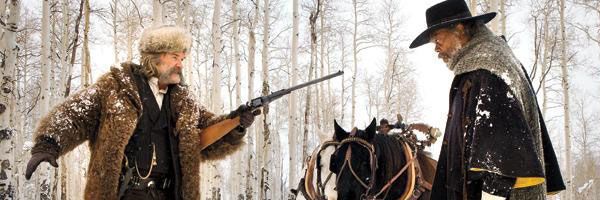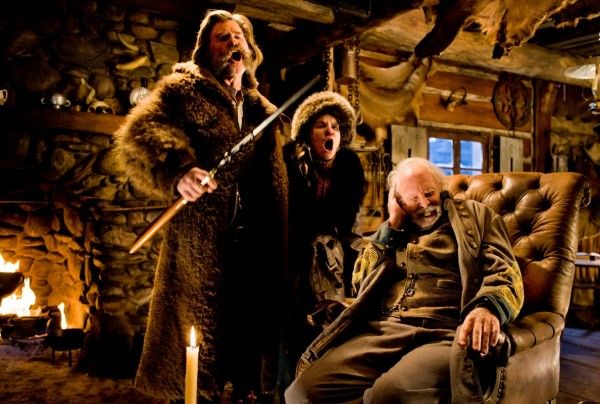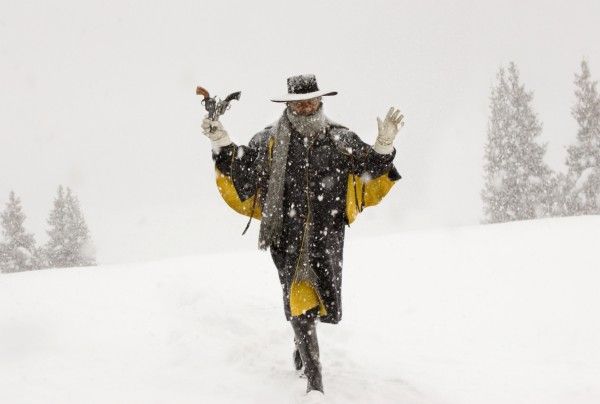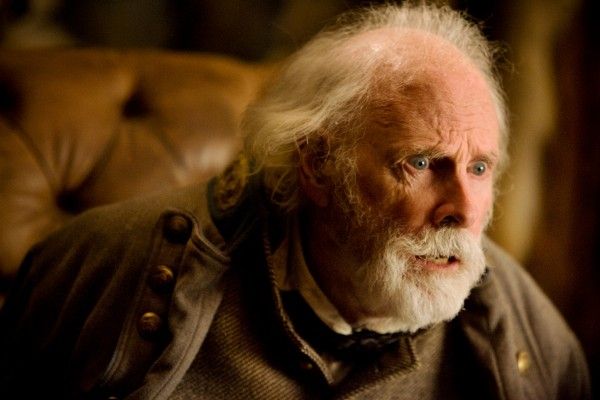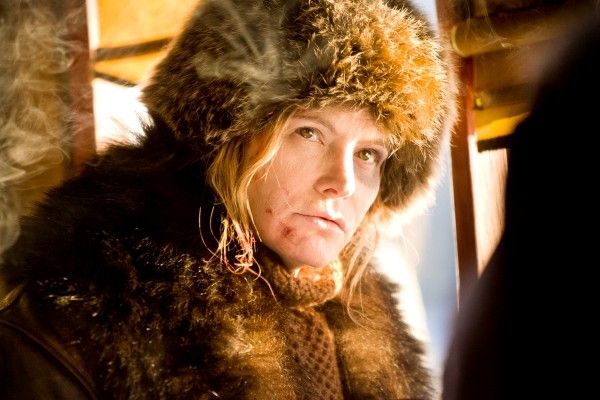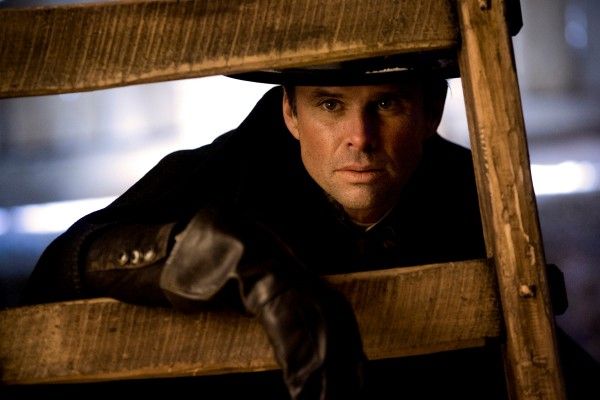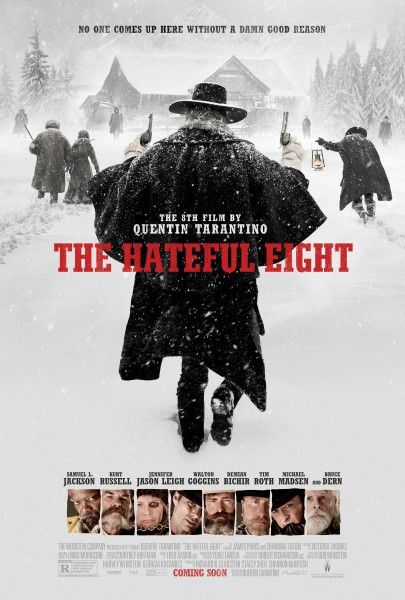The Hateful Eight will not change your opinion on Quentin Tarantino. If you dislike his movies, you will see his latest picture as yet another unceasingly violent and vulgar diatribe. But if you’re like me and think that he has yet to make a bad movie—a fairly remarkable feat since he’s been making theatrical features since 1992—The Hateful Eight is a wonder to behold and an impressive showing of how he continues to grow in subtle ways while maintaining the flavor of his past work.
Tarantino may be comfortable in making his audience uncomfortable, and yet he keeps finding new ways to do it. While not a quantum leap forward in his directing, The Hateful Eight finds a new corner for the filmmaker to explore as both a writer and a director, sticking firmly inside both a setting and a genre so he can explore modern day racial tensions. While Django Unchained was a shotgun blast to the torso of what privileged cultures pretend to see as civilization, The Hateful Eight casts a keen eye towards black-white race relations, but does so with some of the darkest, meanest, and delightful comedy and bloodshed Tarantino has ever concocted.
Set a handful of years after the Civil War, the story takes place in Wyoming and begins with Major Marquis Warren (Samuel L. Jackson) hitching a ride with fellow bounty hunter John “The Hangman” Ruth (Kurt Russell) and his bounty Daisy Domergue (Jennifer Jason Leigh), who are on the way to Red Rock to collect the price on Daisy’s head. Along the way, they pick up former Confederate soldier Chris Mannix (Walton Goggins), who claims to be Red Rock’s new sheriff. A snowstorm waylays the group at Minnie’s Haberdashery, an inn in the mountains that’s already playing host to cowboy Joe Gage (Michael Madsen), the foppish Oswaldo Mobray (Tim Roth), former Confederate General Sandy Smithers (Bruce Dern), and Bob the Mexican (Demian Bichir). Trapped by the storm, the group realizes that they’re all holding secrets and past grudges, and the raging blizzard outside could end up being kinder than the mayhem that’s about to unfold inside.
At first, it seems a little surprising that Tarantino would put so much effort into making sure this film was captured in 65mm Panavision. Aside from some gorgeous shots of the vistas, this is a film that’s largely confined to carriages and the haberdashery. It seemed like Tarantino’s love of film history resulted in a miscalculation, especially in the early going where Warren, Ruth, Domergue, and Mannix are confined inside a carriage. But the director cleverly uses the lens’ ability to capture minute detail to his advantage, and frames that would be mundane in the hands of another auteur are rendered both tense and expansive regardless of the physical boundaries of the scene. While the film wasn’t screened for me in 70mm, I did note how Tarantino was staging his scenes, and I happily pre-ordered tickets for large format once they were available.
I did, however, see it in the roadshow format, which contains an overture and a roughly 12-minute intermission, both of which help add to the atmosphere of the movie even though neither has anything to do with the plot. And yet, the attempt to put the audience in a bit of a time warp is how the film is trying to gain perspective on the present day. Rather than make a movie on race relations set in 2015, Tarantino is doing it by pulling his audience away from current conventions. Ease in with the overture, talk about the film during the intermission, and take it all in with 70mm if possible.
Splitting the film with an intermission does lead to a bit of a tonal shift, and while the movie simmers during the first half, it totally explodes in the second-half. And yet Tarantino narrowly avoids the film from feeling stagey even when you can hear echoes of the April 2014 live read. It’s so rewarding to see Tarantino continue to challenge himself and find new ways to play different tunes, and continue to do so not just because he can. The Hateful Eight doesn’t feel like it’s showing off; it has something to say, and Tarantino still wants to speak about racism.
While some will argue that it’s not Tarantino’s place to talk about racial inequality because he’s white, or that he has to address within certain boundaries, I love that The Hateful Eight shows that he’s still tackling the issue, but couching it in his luscious dialogue and delightful action. Perhaps as white dudes, Tarantino and I can enjoy that privilege, but at the same time, The Hateful Eight is creating a conversation and luring people in with the promise of popcorn entertainment. While the director already did that a few years ago with Django Unchained, The Hateful Eight is a strong companion piece that looks at the conflict not as a critique on civilizations at large, but to the individual players who still have a choice to make.
Whereas Django took the audience across states and various plantations and then gives us the gracious, genteel, but clearly despicable Calvin Candie, The Hateful Eight goes with us into a single location and locks us up with Confederate soldiers like Smithers and Mannix, but the “villain” of the piece is Domergue. If Candie is racism’s ego, trying to hide behind phony science and extravagant wealth, Domergue is the raving lunatic id, frothing at the mouth and spouting off hate speech.
While Domergue could have been reduced to just 19th century trailer trash, Leigh imbues the role with absolute ferocity. She’s unabashedly evil and we want to see her hang, and while this makes for an uncomplicated character, what she brings to the mix is absolutely essential for The Hateful Eight to work (to say any more would start slipping us into spoiler territory). The actress is magnetic, and while the fact that she’s the only major female character in the film opens the door to tricky gender politics, she’s not just a woman in a vacuum. There’s a lot happening with the film, and I credit both Tarantino and Leigh for knowing how to modulate the character’s behavior to make her get beneath the audience’s skin. Domergue may not be Tarantino’s best baddie, but she’ll certainly stay with you.
But the entire cast is outstanding, and in a year full of terrific ensembles, The Hateful Eight may be the best. Every character brings at least a wonderful bit of nuance to the table, and Tarantino plays each like an instrument. As always, no one sings Tarantino dialogue quite like Jackson, who is never better than when he’s working with his Pulp Fiction director; Russell gets to do a full-on John Wayne impression and yet it somehow works; Roth, Dern, Madsen, Bichir all provide some nice bits of harmony to this unusual chorus of characters; and Goggins wonderfully delivers the character arc that also ties into the film’s larger themes, and does so by bringing some of the biggest laughs in a film that’s already painfully funny.
The Hateful Eight may not be Tarantino’s “best” film, but it doesn’t need to be. His return to the Western genre doesn’t feel like a retread of Django, but an essential exploration of themes that couldn’t be completely examined by just one movie, especially one that took place in the antebellum South. While I wouldn’t go so far as to call The Hateful Eight a spiritual sequel to Django, it’s definitely got the same weighty topics on its mind and Tarantino—ever loquacious, bratty, frustratingly brilliant, and shockingly witty—knows just what he wants to say. Hunker down and listen up.
Rating: A

